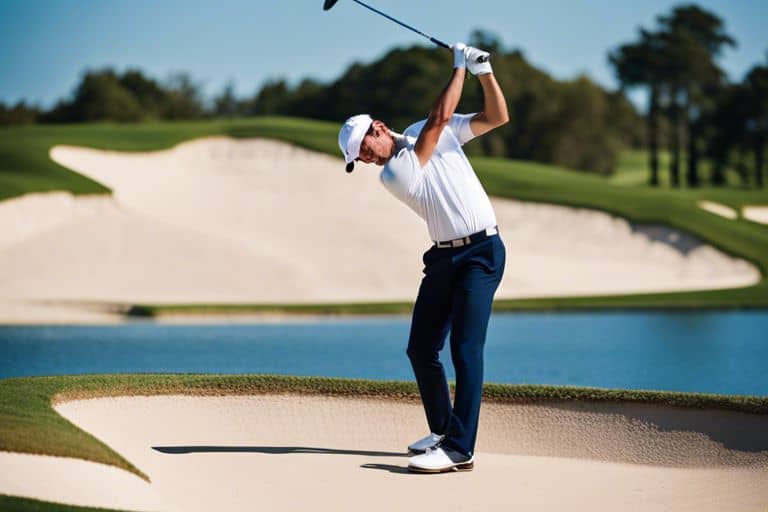What does it mean to "chunk" a shot in golf?
Have you ever found yourself on the fairway, only to chunk your shot and send the ball skidding across the grass for a mere few yards? It’s a frustrating feeling, but understanding what it means to chunk a shot in golf can help you improve your game and avoid those embarrassing moments on the course.
When you chunk a shot, it means you’ve hit the ground before making contact with the ball, resulting in a poor, short shot with little distance and accuracy. Understanding the causes and solutions for chunking can drastically improve your golf game.
The Mechanics of a Chunked Shot
For golfers, the dreaded chunked shot can be a frustrating experience on the course. When you chunk a shot, it means that the club strikes the ground before making contact with the ball, causing the ball to travel only a short distance. The result is often a loss of distance and accuracy, leading to higher scores on the scorecard. In this chapter, I will delve into the mechanics of a chunked shot and provide insights into why it happens and how to prevent it.
The Swing: Causes of a Chunk
When it comes to the swing, there are several common causes of chunked shots. One of the main reasons is an improper weight transfer during the swing. When your weight is too much on your back foot during impact, it can lead to the club bottoming out before reaching the ball.
Another cause can be an overly steep angle of attack, where the club comes down too steeply into the ball, digging into the turf behind it. This can be exacerbated by poor wrist action and a breakdown of the swing plane. Addressing these swing faults can help prevent chunked shots and lead to cleaner ball-striking.
Impact and Turf Interaction
The moment of impact and the interaction between the club and the turf play a crucial role in determining whether a shot will be chunked. If the club strikes the ground before the ball, it disrupts the natural sequence of the swing and effectively “digs” into the turf, causing the chunk. Ground conditions, such as soft or fluffy lies, can exacerbate this issue.
Moreover, the bounce of the club can also influence turf interaction, with excessive bounce leading to a higher likelihood of chunking shots. It’s important to pay attention to these elements to ensure a clean strike and avoid chunking your shots. Remember, a clean ball-turf interaction is crucial for consistent and solid ball-striking.
In summary, understanding the mechanics of a chunked shot can provide valuable insights into how to prevent it. Addressing swing faults and paying attention to impact and turf interaction are essential for improving your ball-striking and avoiding chunked shots. By recognizing and addressing these issues, you can take positive steps toward more consistent and effective golf shots.
Psychological and Physical Consequences
If you have ever chunked a shot in golf, you know how frustrating and demoralizing it can be. Whether it’s hitting the ground before the ball or missing it altogether, the consequences of chunking a shot can have both psychological and physical effects on your game.
The Mental Impact of Chunking Shots
When you chunk a shot, it can have a significant impact on your confidence and mental state. The frustration and embarrassment of making such a mistake can lead to a lack of trust in your own abilities. You may find yourself overthinking your swing, which can cause further errors and impact your overall performance. This negative cycle can be difficult to break, and it is important to address the mental repercussions of chunking shots in order to prevent it from affecting future games.
Physical Adjustments to Prevent Chunking
Chunking a shot can also lead to physical consequences as you may start to make adjustments to your swing in an attempt to prevent future mistakes. However, these adjustments can often lead to further issues and inconsistencies in your game. It is important to address the root cause of the problem and implement effective techniques to prevent chunking without making drastic changes to your swing. This may involve refining your setup, focusing on maintaining a steady tempo, and practicing proper weight transfer to ensure clean contact with the ball.

Strategies for Correction
To correct chunked shots in golf, it’s important to first understand the root cause of the issue. Often, chunked shots occur due to poor weight transfer, lack of focus, or an incorrect setup. By addressing these factors, you can make significant improvements in your shot consistency and overall game.
Drills to Improve Strike Quality
One effective drill to improve strike quality is to practice hitting shots with a towel placed under the ball. This forces you to make clean contact with the ball, without hitting the ground behind it. Another helpful drill is to focus on maintaining a steady lower body through the swing, preventing excessive weight transfer to the back foot which can lead to chunked shots. By incorporating these drills into your practice routine, you can develop the muscle memory and technique needed to avoid chunking the ball.
Equipment and Its Role in Preventing Chunked Shots
Having the right equipment can also play a role in preventing chunked shots. Ensuring that your clubs are fitted to your measurements and swing can make a significant difference in your ability to make clean contact with the ball. Additionally, the condition of your club’s grooves can affect how the ball is struck, so regular maintenance and replacement of clubs when necessary is crucial.

The Meaning of “Chunking” a Shot in Golf
The ability to “chunk” a shot in golf is an essential skill for any player. I hope this article has helped you understand the importance and technique behind successfully chunking a shot on the golf course. By focusing on your weight transfer, proper ball position, and a smooth swing, you can effectively avoid chunking your shots and improve your overall game. Practice these techniques and see the difference in your performance on the course.
